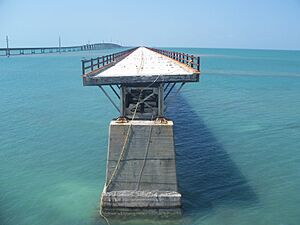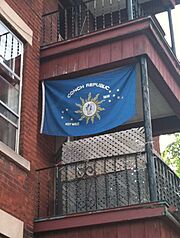Conch Republic facts for kids
Quick facts for kids Conch Republic |
|
| Micronation |
The Conch Republic is a "micronation" that was playfully declared independent from the United States on April 23, 1982. It started in the city of Key West, Florida. Since then, it has become a fun way to attract tourists to the area.
The name "Conch Republic" now refers to all of the Florida Keys. This includes the area up to "Skeeter's Last Chance Saloon" in Florida City. Key West is considered its capital.
Even though these protests were mostly for fun, they came from real problems. The first protest happened because a U.S. Border Patrol checkpoint caused big delays for people living in and visiting Key West.
The Conch Republic celebrates its "Independence Day" every April 23. This is part of a week-long festival. Many local businesses in Key West join in the fun. The group sees itself as a "Sovereign State of Mind." It aims to bring more "humor, warmth and respect" to the world. It is a very important part of tourism for the Florida Keys.
Contents
How the Conch Republic Started
In 1982, the United States Border Patrol set up a checkpoint. This checkpoint was on US 1. This road is one of only two ways to get from the Florida Keys to the mainland. At the checkpoint, cars were stopped and searched for people entering the country illegally.
The Key West City Council complained many times about the checkpoint. They said it made travel difficult for tourists. They also said it hurt the Keys' important tourism business. An airline, Eastern Air Lines, saw a chance to make money. They started offering more flights to Key West International Airport. They hoped people would fly instead of waiting at the checkpoint.
When the U.S. government did not respond, the city council took action. Their attempts to stop the roadblock in court also failed. So, as a form of protest, Mayor Dennis Wardlow and the council declared Key West's independence. This happened on April 23, 1982. The council felt that since the U.S. government was treating them like a foreign country, they might as well become one. Many local people were called Conchs. So, the new "micronation" was named the Conch Republic.
As part of the protest, Mayor Wardlow was named "Prime Minister." The republic then playfully "declared war" on the United States. This was done by breaking a loaf of stale Cuban bread over a man dressed in a naval uniform. They then "surrendered" after just one minute. After that, they asked for one billion dollars in "foreign aid."
Conch Republic officials were even invited to a big meeting in Miami in 1994. This was called the Summit of the Americas. In 1995, Conch representatives were officially invited to Florida's Jubilee celebration.
This playful "secession" and the events around it brought a lot of attention to the Keys' problems. The roadblock was removed soon after. It also created a new way to attract tourists to the Florida Keys.
Playful "Invasions" in 1995
On September 20, 1995, a U.S. Army Reserve unit planned a training exercise. They were going to pretend to invade a foreign island. They would land on Key West and act as if the islanders were foreign. But, no one told the Conch Republic officials about this plan.
Mayor Wardlow and the Conch Republic leaders saw a chance for more publicity. They prepared the island for a "full-scale war." The schooner Western Union went out to "attack" a Coast Guard cutter. They used water balloons, conch fritters, and stale Cuban bread. The Coast Guard responded with their fire hoses, ending the "battle" quickly. The Conch Republic also protested to the Department of Defense. They were upset that the exercise happened without talking to city officials. The Army leaders apologized the next day. They said they "in no way meant to challenge or impugn the sovereignty of the Conch Republic." They even took part in a surrender ceremony on September 22.
During a U.S. government shutdown in 1995 and 1996, the republic protested again. They sent a group of boats to Fort Jefferson. This fort is in Dry Tortugas National Park. They wanted to reopen the park. Local people had raised money to keep the park open. A closed park would hurt the local tourism. But they could not find anyone to accept the money and reopen the park.
When officials tried to enter the monument, they received a legal notice. The case was later dropped in court.
Claiming the Seven Mile Bridge
On January 13, 2006, Peter Anderson claimed the old part of Seven Mile Bridge for the Republic. This part of the bridge was no longer used. It had been replaced by a new bridge in 1982. This action was a response to a situation with Cuban refugees. Earlier, 15 Cuban refugees reached the bridge. But they were sent back to Cuba by the U.S. Border Patrol. This was because the U.S. government said the bridge was a "wet feet" location. This meant it was not considered U.S. land.
Anderson used the U.S. government's statement to claim the bridge for the Conch Republic. He hoped to use the bridge for affordable homes. Florida's governor's spokesman said the bridge belonged to all Floridians. The decision about the refugees was later changed. But it was too late, as the refugees had already been sent back to Cuba.
Recent News
Starting in 2008, the northern Keys, including Key Largo, formed their own group. They called themselves the Independent Northernmost Territories of the Conch Republic. They said this separation happened because of disagreements about what "Conch Republic" means.
As of 2022, the sign at the southernmost point buoy in Key West still mentions the Conch Republic.
Souvenir Passports and Vehicle Stickers
The Conch Republic sells "passports" on its website. These are meant to be fun souvenirs. However, some people have bought them thinking they were real travel documents. After a major event in 2001, investigators looked into whether one of the people involved had bought a Conch Republic passport. This showed that some people might have misunderstood what the passports were for.
You can also buy stickers for your car in Key West. These stickers have the letters "KW" and "CR." These are the international codes for Kuwait and Costa Rica.
Conch Republic "Military"
The Conch Republic has an "Army," "Navy," and "Air Force." Their main job is to help re-enact the "Great Sea Battle of 1982." They also re-enact the "retaking" of Fort Jefferson. The Conch Republic Navy has at least 10 civilian boats. It also includes the schooner Wolf.
The "Army" includes the 1st Conch Artillery. They are based at Fort Taylor.
The Conch Republic "Air Force" has more than a dozen planes. Their main plane is a 1942 Waco. It was flown by Fred R. Cabanas. He was a famous stunt pilot and an ambassador for the Conch Republic. He flew "Conch Fury" in the 2005 Reno Air Races. Fred was named General of the Air Force by the mayor of Key West. This happened after he "intercepted" a Cuban MiG-23 with his Pitts Special in 1991. After he passed away in 2013, his son, Raymond Cabanas, took over.
In Books
Some stories in books have taken place in the Conch Republic.
In Joe Haldeman's 1989 science fiction novel Buying Time, some of the action happens in the Conch Republic. In this story, it is shown as a place where rules are loose.
Science fiction writer Spider Robinson's Callahan's Crosstime Saloon series is about an Irish bar. It is full of time travelers, aliens, and musicians. In the 2000 novel Callahan's Key, the characters move to the Conch Republic.
National Anthem
In 1994, Joe and Meri-Lynn Britz wrote the national anthem for the Conch Republic. It is simply called "Conch Republic." The Key Lime Pie band recorded it. The Key West City Commissioners voted on it and accepted it.
See also
 In Spanish: República de Concha para niños
In Spanish: República de Concha para niños



